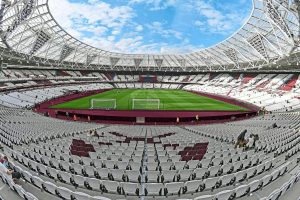The London Stadium is the current home of Premier League West Ham United. It is perhaps more famously the host venue for the 2012 London Olympic games.
From a West Ham perspective the story of the Olympic Stadium is a complicated one fraught with legal infighting.
When the Olympic games were awarded to London on the 5th of July 2005 West Ham had little or no interest in moving to Stratford. What’s currently known as The London Stadium was set to be the centrepiece of the games. The games proved successful, with numerous iconic moments. The likes of Mo Farah, Usain Bolt and Jessica Ennis helped create a memorable event.
UK athletics were set to be the main beneficiaries of the stadium which would become the home of British Athletics once the games were completed. UKA agreed to provide some funding towards the building of the stadium with other sporting bodies also being approached to assist with funding.
West Ham take control
Following the takeover of the club by Icelandic businessman Björgólfur Guðmundsson in June 2006, West Ham were approached with a view to eventually taking over control of the stadium. A collaboration with UK Athletics would have seen the stadium constructed in such a way that it could be easily transformed between football and athletics.
West Ham’s board declined the invitation to invest in the stadium’s construction. It was later announced that the venue would be a 90,000 athletics venue for the games then reduce to a 25,000 capacity athletics stadium after the event. Currently the London Stadium boasts a 66,000 capacity making it the third largest football stadium in England.
The full details of the construction can be found elsewhere, but The Olympic Stadium was constructed in such a way that the bottom tier was designed to be permanent, with the upper section intended to be dismantled.
Following a takeover at West Ham by David Gold and David Sullivan in 2009, the new Hammers board announced their intention to move to the Olympic Stadium.
What followed was a complex and tenuous situation. It was agreed that stadium would fall into the joint ownership of UK Athletics and West Ham United. However this was challenged by Daniel Levy and Barry Hearn who were the chairmen of Tottenham and Leyton Orient.
Following months of wrangling it was decided that the Olympic Stadium would be leased rather than sold. West Ham won the rights to lease the stadium during the football season on a 99 year agreement.
Botched transformation
What followed was a rather botched attempt to transform the venue. Initial construction that had been designed as a temporary athletics venue into a football and track & field arena.
Engineering issues with roof and retractable seating continue to this day due to the lack of initial planning. This is in stark contrast to Manchester City’s Etihad stadium which was jointly planned with Manchester council. The council and club planed to transform the venue into a football ground following the 2002 Commonwealth Games.
West Ham United left The Boleyn Ground, Upton Park to move to the newly named London Stadium in 2016. The general running of the stadium is undertaken by the London Legacy Development Corporation (LLDC). The stadium operators continue to have have a fraught relationship with West Ham.
The London Stadium continues to make huge annual losses and remains subsidised by the taxpayer.

